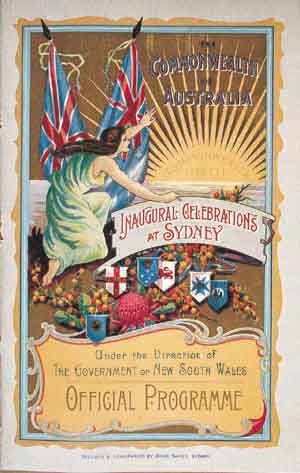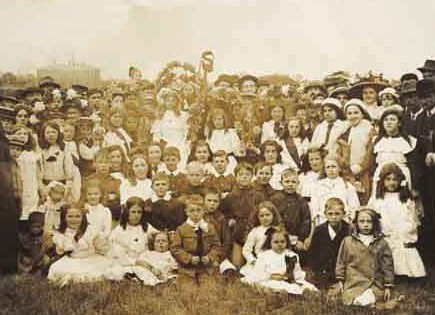
YOUNG JOHN CURTIN
The major official celebrations to mark Australia's federation as one nation took place in Sydney. In Melbourne, it was a muted affair, although Parliament House was illuminated for the occasion and a few ceremonial arches were erected - but not nearly so many as in Sydney. In Curtin's suburb, Brunswick, the celebrations were postponed until 11 February, out of respect for Queen Victoria who died in January 1901. Curtin would, perhaps, have been more familiar with some of the issues of federation than many boys of his age because his father took him to meetings during the campaigns.

Official Program to the Commonwealth of Australia inaugural celebrations at Sydney, 1901.
By Permission of the National Library of Australia. Image No. 16164.
The ideals that reached their climax at the end of the century in the federations of the Commonwealth were interpreted by each according to his needs and experiences. To Curtin, they were an almost fanatical belief in the future of a new Australia for the people, the importance of mateship, comradeship, solidarity; hopes of a world of peace, prosperity, equality and security; the federation of Australia and of the world
(Ross, 1977, p. 6).
Curtin celebrated his sixteenth birthday on 8 January 1901, a week after the official ceremony to mark Australia's Federation. He was either unemployed or earning a low wage in a temporary position - his first job as a message boy in 1899, at the age of fourteen, had paid five shillings a week. He lived with his family in a weatherboard cottage in Brunswick's Irish Quarter. [1] Curtin later described it as an existence of 'tea without milk and bread without butter', and without privacy - he had to share a bed with his younger brother, George (Day, 1999, pp. 50-58).
In perhaps his first real step towards independence from his parents, Curtin had joined the Salvation Army sometime in the previous year. Day suggested that he was attracted to the Salvationists and away from the faith of his parents because the Catholic Church provided 'charity through the St Vincent de Paul Society and otherwise offered the solace of prayer so that its parishioners might become resigned to their lot', but the Salvation Army 'worked to change the world'. Curtin, Day observed (p. 53), 'seemed to have been determined to change the social conditions of his impoverished world' from an early age.
But he soon sought other means to effect change. In 1902, he attended a public meeting in East Brunswick, at which the speaker was Frank Anstey, then a State Member of Parliament. Curtin moved a vote of thanks, and thus met the first of three men who were to have a profound influence on his life. British-born Anstey had arrived in Australia after stowing away on a ship at the age of eleven. Anstey was a member of the Tocsin Clubs, which were forerunners of the Labor Leagues, and a founder of the Labor Party in Victoria. The second man was the British Socialist, Tom Mann, who arrived in Melbourne the same year and who worked for a time, with great success, as organiser for the Victorian Labor Party. Mann had gone down the pit at the age of ten, and later, as an apprentice, joined the Amalgamated Society of Engineers. He was sacked from his job because of his political opinions, and thus became an agitator. He was involved in a number of strikes in England, most notably the London dock strike of 1889, to which Australian unionists contributed generous donations. The third man was Frank Hyett, Curtin's senior by only three years, whom he first met at the Brunswick Football Club in 1903 (Day, pp. 63-72). According to Ross (pp. 12-13), Anstey instigated in Curtin his hatred of militarism and his belief that imperialism and nationalism were not two sides of the same coin - as many pro-Federationists had believed - but were, in fact, irreconcilable. From Mann, he gained encouragement in his striving to achieve social, political and economic equality for the vast, underprivileged mass of workers like himself. Mann reiterated: 'We are out to abolish poverty'. Hyett was more a friend than a mentor, but the age difference and Hyett's habit of excelling in Curtin's chosen fields of endeavour meant that John was not entirely Frank's equal. In September 1903, Curtin at last secured a permanent position as an estimates clerk at the Titan Manufacturing Company in South Melbourne. He worked a 48-hour, six-day week for a pay of 35 shillings, most of which provided for the upkeep of his parents and younger siblings (Day, pp. 72-73, 134).

John Curtin Prime Ministerial Library. Records of the
National Library of Australia. Victorian Socialist Party
Sunday School Pupils & teachers, including R Ross and Yatala Bruce.
n.d. JCPML00438/7.
Original held by the National Library of Australia. MS3939, series 11,
folder 66.
Politically,
it was an exciting and optimistic time for young Socialists. The Australian
Labor Party gained government, under the leadership of John Christian
Watson, and was in office for four months from 23 April 1904. Labour movements
around Australia were greatly encouraged by this brief electoral success.
Unfortunately, Watson exhausted himself trying to get at least a small
portion of Labor's reforms enshrined in legislation,
without compromising the Party's principles too drastically. [2]
Ironically, the world's first national Labor government resigned when
a majority in the House of Representatives voted against Watson's proposal
to grant preference of employment to unionists participating in the decisions
of the proposed Arbitration Court (McMullin, 1991, p. 51). A temporary
coalition of free traders and protectionists guided the amended bill through
parliament and passed an Act establishing a federal tribunal and a system
of compulsory conciliation and arbitration to deal with inter-state disputes.
Shortly afterwards, the High Court ruled that the Arbitration Court had
no power to deal with state government railway employees, and, by implication,
with any other state employees (Crowley, 1974:1980, p. 282). Although
successive Labor governments tried to overturn this ruling by introducing
referenda in 1911, 1913 and 1915, all of these failed.